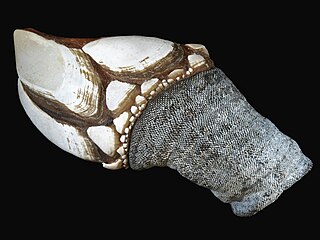
A barnacle is a type of arthropod constituting the subclass Cirripedia in the subphylum Crustacea, and is hence related to crabs and lobsters. Barnacles are exclusively marine, and tend to live in shallow and tidal waters, typically in erosive settings. They are sessile (nonmobile) and most are suspension feeders, but those in infraclass Rhizocephala are highly specialized parasites on crustaceans. They have four nektonic larval stages. Around 1,000 barnacle species are currently known. The name "Cirripedia" is Latin, meaning "curl-footed". The study of barnacles is called cirripedology.

Balanus is a genus of barnacles in the family Balanidae of the subphylum Crustacea.

Acorn barnacle and acorn shell are vernacular names for certain types of stalkless barnacles, generally excluding Pedunculata. As adults they are typically cone-shaped, symmetrical, and attached to rocks or other fixed objects in the ocean. Members of the barnacle order Balanomorpha are often called acorn barnacles.

Semibalanus balanoides is a common and widespread boreo-arctic species of acorn barnacle. It is common on rocks and other substrates in the intertidal zone of north-western Europe and both coasts of North America.

Whale barnacles are species of acorn barnacle that belong to the family Coronulidae. They typically attach to baleen whales, and sometimes settle on toothed whales. The whale barnacles diverged from the turtle barnacles about three million years ago.

Megabalanus is a genus of barnacles in the family Balanidae. Members of the genus grow to 7 cm (2.8 in) in length and inhabit the lower intertidal zone.

Chthamalus stellatus, common name Poli's stellate barnacle, is a species of acorn barnacle common on rocky shores in South West England, Ireland, and Southern Europe. It is named after Giuseppe Saverio Poli.

Pollicipes pollicipes, known as the goose neck barnacle, goose barnacle or leaf barnacle is a species of goose barnacle, also well known under the taxonomic synonym Pollicipes cornucopia. It is closely related to Pollicipes polymerus, a species with the same common names, but found on the Pacific coast of North America, and to Pollicipes elegans a species from the coast of Chile. It is found on rocky shores in the north-east Atlantic Ocean and is prized as a delicacy, especially in the Iberian Peninsula.

Balanus nubilus, commonly called the giant acorn barnacle, is the world's largest barnacle, reaching a diameter of 15 cm (6 in) and a height of up to 30 cm (12 in), and containing the largest known muscle fibres.

Amphibalanus improvisus, the bay barnacle, is a species of acorn barnacle in the family Balanidae.

Amphibalanus amphitrite is a species of acorn barnacle in the Balanidae family. Its common names include the striped barnacle, the purple acorn barnacle and Amphitrite's rock barnacle. It is found in warm and temperate waters worldwide.
Megabalanus stultus is a species of barnacle first described by Charles Darwin in 1854. It lives on fire corals of the genus Millepora in the Atlantic Ocean from Florida to southern Brazil.

Pollicipes polymerus, commonly known as the gooseneck barnacle or leaf barnacle, is a species of stalked barnacle. It is found, often in great numbers, on rocky shores on the Pacific coasts of North America.

Megabalanus tintinnabulum is a species of large barnacle in the family Balanidae. It is the type species of the genus. The specific name comes from the Latin tintinnabulum meaning a handbell and probably refers to the fact that small groups of barnacles resemble clusters of miniature bells.

Amphibalanus eburneus, the ivory barnacle, is a species of acorn barnacle in the family Balanidae. It occurs on the east coast of North America, the Caribbean Sea and Gulf of Mexico.

Catomerus is a monotypic genus of intertidal/shallow water acorn barnacle that is found in warm temperate waters of Australia. The genus and species is very easily identified by whorls of small plates surrounding the base of the primary shell wall; no other shoreline barnacle species in the Southern Hemisphere has that feature. This species is considered to be a relic, as these plates are found only in primitive living lineages of acorn barnacles or in older fossil species. The fact that this is an intertidal species is unusual, because living primitive relic species are often found in more isolated habitats such as deep ocean basins and abyssal hydrothermal vents.
The barnacle genus Nesochthamalus was erected by Foster & Newman, 1987, to include sole species Chthamalus intertextus originally named by Darwin in 1854. It is widespread on islands in Western Pacific Ocean, including Hawaii, and presents combinations of unusual features which make easily recognizable for field workers. These include dirty white shell exterior with deep purple colored interior, operculars colored purple. Opercular plates on each side calcify together in all but youngest individuals, and cannot be separated or easily distinguished from each other. This feature is shared only by Rehderella belyaevi, but in latter species, scutum and tergum can be distinguished by raised ridge replacing old articular margin. Unique feature of Nesochthamalus is its basis. In young individuals, it is entirely membraneous, and with age, becomes secondarily calcareous progressively inwards, leaving only the center membraneous. As the basis calcifies, it rises off the substrate forming a saucer shape when viewed from the side. In addition, interior of shell is secondarily calcified.
Megabalanus californicus, the California barnacle, is a species of large barnacle in the family Balanidae. It is native to rocky coasts in the Eastern Pacific Ocean from North California to the Gulf of California.

Tetraclita rubescens, the pink volcano barnacle, is a species of sessile barnacle in the family Tetraclitidae.















